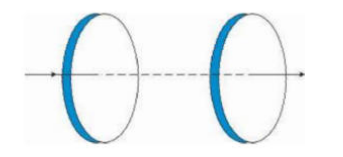Answer carefully: If Coulomb’s law involved 1/r3 dependence (instead of 1/r2), would Gauss’s law be still true ?Solution in Punjabi
Step by step video & image solution for Answer carefully: If Coulomb’s law involved 1//r^3 dependence (instead of 1//r^2), would Gauss’s law be still true ? by Physics experts to help you in doubts & scoring excellent marks in Class 12 exams.
Updated on:21/07/2023Topper's Solved these Questions
Similar Questions
Figure 8.6 shows a capacitor made of two circular plates each of radius 12 cm, and separated by 5.0 cm. The capacitor is being charged by an external source (not shown in the figure). The charging current is constant and equal to 0.15A. Calculate the capacitance and the rate of change of potential difference between the plates. :

View SolutionAnswer the following questions regarding earth’s magnetism:A vector needs three quantities for Its specification. Name the three Independent quantities conventionally used to specify the earth’s magnetic field.
View SolutionIf Coulomb's law involved 1/r^3 (instead of 1/r^2) , would Gauss's law still be true?
View SolutionSuppose the law of gravitational attraction suddenly changes and becomes an inverse cube law i.e. F∝1/r3, but still remaining a central force. Then
View SolutionMendel's law is still true because it takes place in:
View SolutionGauss’s law states that
View SolutionIf Coulomb's law involved 1/r3 dependence (instead of 1/r2), would Gauss's law be still true ?
View SolutionIf Coulomb's law involved 1/(r^3) dependence (instead of 1/(r^2) ), would Gauss'law be still true?
View Solutionयदि कॉलम नियम में 1r2 के स्थान पर निर्भरता 1r3 होती तो क्या गाउस नियम सत्य होता
View SolutionIf It is 1/r^2.5 in place of 1/r^2 , would Gauss's law still hold?
View SolutionIf Coulomb's law involved 1/r3 dependence (instead of 1/r2), would Gauss's law be still true ?
View SolutionAnswer carefully:
(a) Two large conducting spheres carrying charges Q1 and Q2 are brought close to each other. Is the magnitude of electrostatic force between them exactly given by Q1,Q2/4πε0r2, where r is the distance between their centres?
(b) If Coulomb’s law involved 1/r3 dependence (instead of would Gauss’s law be still true ?
(c) A small test charge is released at rest at a point in an electrostatic field configuration. Will it travel along the field line passing through that point?
(d) What is the work done by the field of a nucleus in a complete circular orbit of the electron? What if the orbit is elliptical?
(e) We know that electric field is discontinuous across the surface of a charged conductor. Is electric potential also discontinuous there?
(f) What meaning would you give to the capacitance of a single conductor?
(g) Guess a possible reason why water has a much greater dielectric constant (= 80) than say, mica (= 6).
View SolutionIn Coulomb’s law, on what factors the value of electrostatic force Constant ‘K’ depends ?
View SolutionState the limitations of Coulomb’s law.
View SolutionState Gauss’s theorem.How Coulomb’s law can be derived from it ?
View SolutionGauss’s law should be invalid if
View Solution
